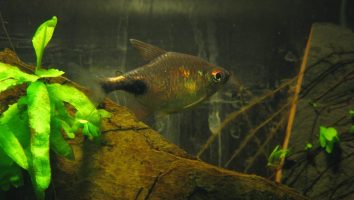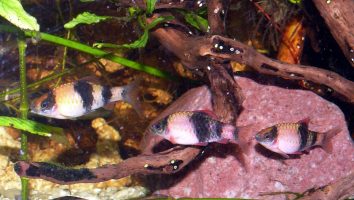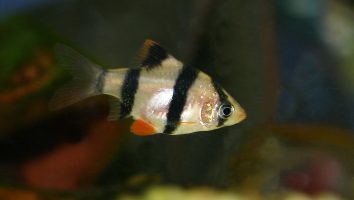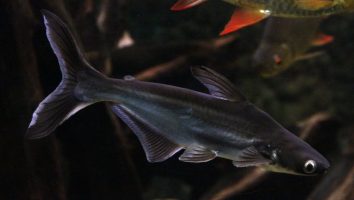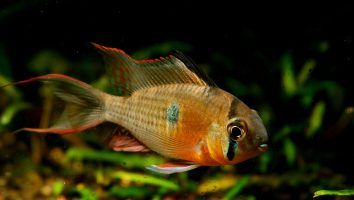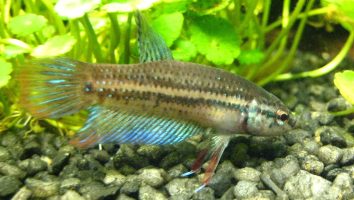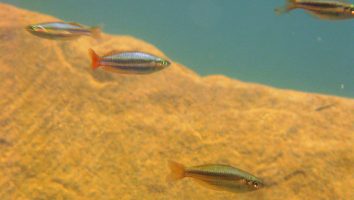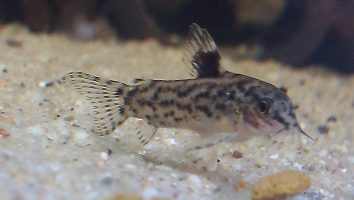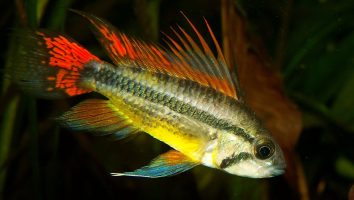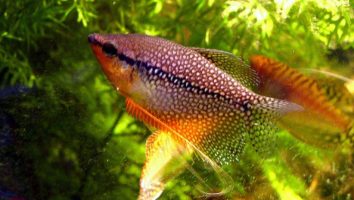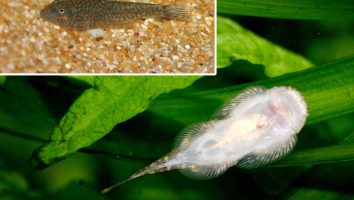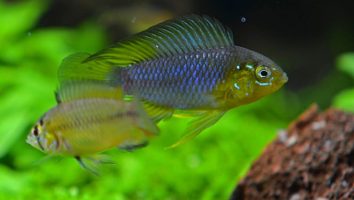The Mbu Puffer is a freshwater fish that is native to Africa. They are known for their large size and voracious appetite.
Mbu Puffers are a popular choice for aquariums because of their unique appearance and personality. However, they are not a fish for beginners.
Mbu Puffers require a large tank, a good filtration system, and a lot of patience. This guide will teach you everything you need to know about Mbu Puffer care.
Table of contents
Species overview
The Mbu puffer (scientific name: Tetraodon mbu) is a freshwater fish that’s native to the Congo River basin in Central Africa.
This fish is quite large, reaching up to two feet in length! They are a type of pufferfish, which means they have the ability to inflate their bodies with water (or air) to deter predators.
Mbu pufferfish are not a common sight in the aquarium trade, but they are starting to become more popular due to their unique appearance and size.
If you’re thinking about getting an Mbu puffer, it’s important to note that they require a very large tank (at least 100 gallons) and should only be kept with other large, non-aggressive fish.
Appearance
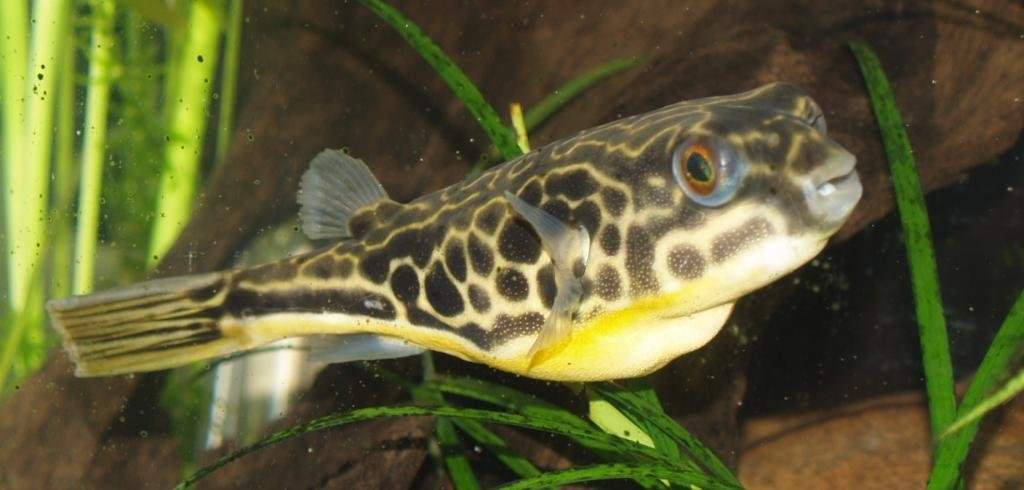
The Mbu Puffer is one of the largest freshwater fish in the world and can reach up to 4 feet in length!
Despite their large size, they are very peaceful fish and are often found in community tanks.
Mbu Puffers are dark gray or black in color with white spots all over their bodies. They have a large, round body with a very wide mouth. They have small eyes and large fins.
The dorsal fin is tall and triangular, while the anal fin is shorter and rounded. The caudal fin is forked and the pectoral fins are large and paddle-shaped.
Lifespan
The Mbu puffer can live for 20 years or more in captivity with proper care. These fish are very sensitive to water quality and need a well-maintained tank to thrive. They’re also susceptible to stress and need to be kept in a peaceful tank with appropriate tank mates.
Size
Mbu pufferfish can reach a whopping 24 inches in length, making them one of the largest freshwater aquarium fish available. They are a slow-growing species, however, so it will take several years for them to reach their full size.
Tank
Tank Size
Mbu pufferfish need a lot of space to swim and should ideally be kept in an aquarium of at least 180 gallons. If you don’t have that much space available, you can try keeping them in a 125-gallon tank but they may not do as well in the long run.
These fish are also known to be jumpers so it’s important to have a tight-fitting lid on your tank to prevent them from escaping.
Water Parameters
The Mbu Puffer is a freshwater fish that is found in the Congo River Basin. They are a very large fish, with some specimens reaching up to two feet in length.
The Mbu Puffer is a very unique fish with a number of different physical characteristics. They have a large mouth that is filled with sharp teeth, and they also have a very large stomach.
The Mbu Puffer is a very aggressive fish, and they are known to attack other fish in the tank. They are also known to be very messy eaters, and they will often leave a large mess in the tank after they have eaten.
The Mbu Puffer is a very sensitive fish, and they are very sensitive to changes in water parameters. It is very important to keep the water quality in the tank very high, and to make sure that the water parameters are stable.
The Mbu Puffer is a very sensitive fish, and they are very sensitive to changes in water parameters. It is very important to keep the water quality in the tank very high, and to make sure that the water parameters are stable.
- Water temperature: 72 to 82 degrees Fahrenheit
- pH levels: 6.5 to 7.5
- Water hardness: 5 to 15 dGH
- Alkalinity Levels: 4-8 dKH
What To Put In Their Tank
Mbu puffer fish are one of the few freshwater species of pufferfish. They’re also one of the largest, which means they require a pretty big tank.
When it comes to setting up their habitat, you have a few different options.
You can go with a standard gravel substrate, but we prefer something a little softer. These fish like to dig, and a softer substrate will be easier on their fins.
You should also include some plants in their tank. These fish are known to nibble on vegetation, but they generally won’t do too much damage. Hornwort, water wisteria, and Java moss are all great choices.
Rocks, driftwood, and caves are all suitable as well. It’s important to avoid going overboard with this since these fish like some room to swim.
A classic gravel substrate is always a good choice, but you can do with something soft and sandy if needed too (use other species you keep as a guide with this).
Common Diseases
The Mbu Puffer is a freshwater fish that is rather hardy and resistant to disease. However, they are not immune to illness and can still fall ill if the water conditions in their tank are not up to par.
The most common disease that affects this species is ich. This is a parasitic infection that will present itself as white spots on the body, fins, and gills of your fish.
If left untreated, ich can be fatal. However, it is fairly easy to treat if you catch it early.
Another disease that can affect the Mbu Puffer is hole-in-the-head disease. This is a condition that is caused by poor water quality and the presence of activated carbon in the tank.
It will present itself as pits or holes in the skin on the head of your fish. While it is not usually fatal, it can be quite uncomfortable for your fish and will usually leave some scarring.
The best way to prevent your Mbu Puffer from getting sick is to maintain clean and stable water conditions in their tank. A well-maintained tank will lead to healthier fish who are more resistant to disease.
Behavior & Temperament
The Mbu Puffer is one of the largest freshwater fish in the world, and they have the personality to match their size. They are a top predator in their environment and have been known to attack and eat other fish, even ones that are much larger than them.
They are also known to be very aggressive towards other Mbu Puffers. In fact, it’s recommended that you only keep one Mbu Puffer per tank unless you have a very large tank and you’re sure that they will have enough space to avoid each other.
Mbu Puffers are also known to be escape artists. They are strong swimmers and can jump out of the water, so it’s important to have a tight-fitting lid on your tank.
Overall, Mbu Puffers are not a good choice for a community tank. They are better suited for a single-species tank or a tank with fish that are much larger than them.
Tank Mates
The Mbu Puffer is a large, aggressive freshwater fish. As a result, they are not compatible with most tank mates.
In fact, the only fish that can safely be kept with them are other large, aggressive fish.
Some examples of compatible tank mates include:
- Other Mbunas
- Peacock Cichlids
- Flowerhorn Cichlids
- Oscar Cichlids
- Green Terror Cichlids
- Jack Dempsey Cichlids
- Convict Cichlids
Breeding
Mbu pufferfish are not easy to breed in captivity. It is estimated that only about 1% of fry survive to adulthood. However, if you are determined to try, there are a few things you can do to improve your chances of success.
First, you need to set up a large tank. Mbu puffers can grow to be over a foot long, so you will need at least a 200 gallon tank. The tank should have plenty of hiding places and a sandy bottom.
Next, you need to find a group of Mbu puffers. It is best to have at least 6 fish, but more is better. You will need to sex the fish to make sure you have a good ratio of males to females.
Once you have your fish, you need to slowly acclimate them to the new tank. This process can take several weeks. During this time, you should feed the fish live food.
When the fish are acclimated, you can start to induce spawning. This is done by slowly raising the water temperature over the course of a few days. Once the temperature reaches 86 degrees Fahrenheit, the fish should start to spawn.
The female Mbu puffer will lay her eggs on the sandy bottom of the tank. The male will then fertilize them. Once the eggs are fertilized, the female will leave the area and the male will stay to guard the eggs.
The eggs will hatch in about 5 days. The fry will be very tiny and will need to be fed live food. After a few weeks, you can start to feed them frozen food.
Mbu pufferfish are not easy to breed in captivity, but it is possible with patience and dedication.
Conclusion
Mbu Pufferfish are one of the most unique and interesting freshwater fish you can keep. They’re not for everyone, but if you’re up for the challenge then we think you’ll be very happy with them.
They’re not the easiest fish to take care of, but they’re definitely not the hardest either. With a little bit of research and planning, you should be able to provide them with the care they need to thrive.
If you’re looking for a fish that will really stand out in your tank, then the Mbu Pufferfish is definitely worth considering.

